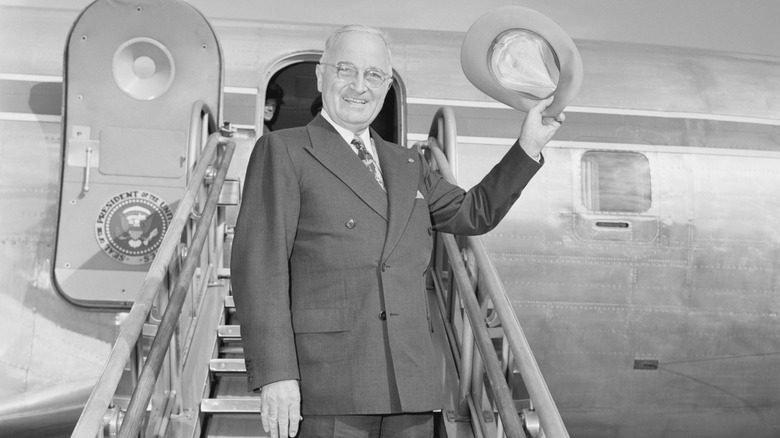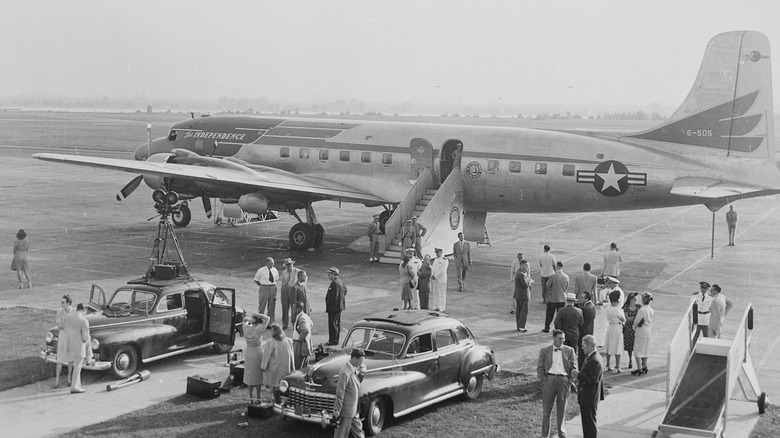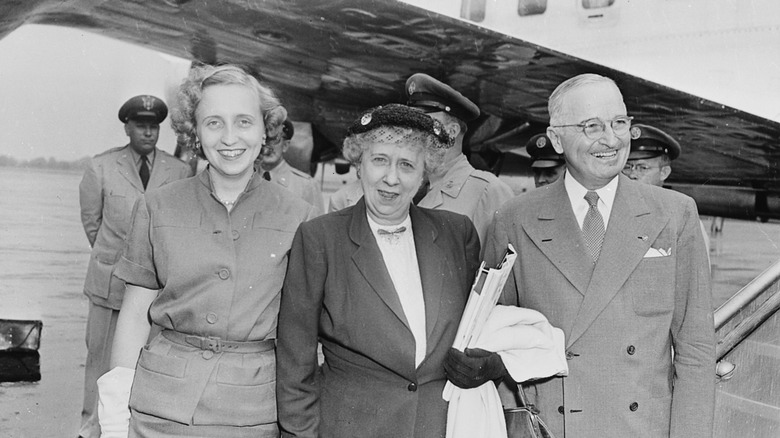Harry Truman's Air Force One Was No Ordinary Plane – Here's What It Looks Like Today
While the U.S. President today typically flies in one of two modified Boeing 747-200s, these aircraft are not the only Air Force Ones. In fact, it's a call sign that refers to any Air Force aircraft currently carrying the president. There have been a wide range of aircraft that carried the illustrious "Air Force One" moniker over the years, with some remarkable paint jobs and liveries too. But some exclusive presidential aircraft existed prior to the call sign's establishment. One notable example is the propeller airplane that belonged to Harry Truman, which was only the second aircraft specifically designed to carry the president.
It was a Douglas VC-118 dubbed "The Independence," named after Truman's hometown in Missouri. Much like Boeing's 747-200 that has become internationally recognized as Air Force One, it was uniquely modified for its important role and became a fascinating aircraft steeped in history. One of the major characteristics that set The Independence apart was its thoroughly patriotic color scheme, complete with the American eagle.
While it isn't flown as the president's official aircraft anymore (retired in 1953), it has a proud legacy among them and is a popular museum display piece. It's currently housed at the National Museum of the United States Air Force in Ohio, where it has rested since 1965. A little over a decade later, its color scheme was restored to its luxurious presidential livery. It now essentially looks just as it did when it entered then-President Truman's service.
The historical significance of The Independence
World War II highlighted the importance of having a rapid response and long-range aircraft. The first aircraft designed to achieve just that was the Sacred Cow, a Douglas C-54 Skymaster that was fitted with a meeting room, elevator, and other features to help President Franklin D. Roosevelt monitor events. With a range of some 4,000 miles, it was designed to be able to reach the places it needed to be in short order, and this was also a big part of the design of The Independence, which was introduced shortly after WW II, in 1947.
Aside from a single journey to the Yalta Conference, where Allied leaders planned how to overcome Nazi Germany, the Sacred Cow was never actually used by Roosevelt. A more capable and rather more up-to-date model was required, and thus The Independence came to be. Presidential aircraft have always had amazing features, in the many forms they've taken. The Independence was given water-injected engines, more advanced radar systems, weather monitoring equipment, and other critical capabilities an airborne command center would need (including a plush room for President Truman in the rear of the aircraft).
It sports four R-2800 Pratt & Whitney engines, which offer a combined total of 8,400 horsepower, translating to a range of 4,430 miles and a top speed of 360 mph. It was equipped to hold 25 passengers, including the president, and a crew of nine. The history of presidential aircraft is fascinating, and this model is another beauty.
The Independence's restoration
President Truman first flew in the vessel in August 1947, and it remained the president's official plane for six years. It flew for another 12 years before being taken to its new home. There, reports the National Museum of the United States Air Force, it can not only be visited but passed through, offering a chance to admire its rather roomy interior.
Being an important historical artifact, restoration efforts were necessary to prevent the iconic aircraft from deteriorating too badly. In performing any such work, of course, the danger is that replacing and renovating can take away from the historical value of the attraction. Replication, then, has to be utterly authentic, and this was performed to a painstaking degree in 2015. The most delicate of artefacts were cleaned and dusted with toothbrushes. The most difficult to care for leather surfaces were hand-stitched back to health.
Interestingly, damage had to be cared for, too. Jennifer Myers, Museum Conservator, explained (via the National Museum of the United States Air Force) that "people smoked a lot in this plane when it was flying ... there were even ash trays in the cockpit. It was really a sign of the times." For a lot of today's younger flyers, it might be almost inconceivable to think that smoking used to be not only permitted but commonplace on flights. The staining and other damage from such on The Independence was also taken care of during the restoration of the history-making aircraft. The goal was to return it to the condition in which it had been when President Truman and his entourage flew in it, or even better in the case of the smoking damage.


